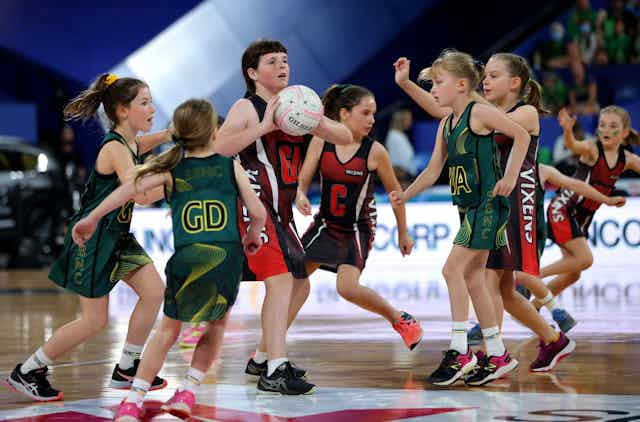Netball is one of the biggest team sports in Australia with more than 1.2 million men, women and children playing each week, underpinned by a nationwide footprint of more than 4,000 community clubs.
Across the world more than 20 million people play netball in more than 70 countries. And it’s not just for young women; men play in mixed and male only competitions, 5-7 year olds play in the NEtSetGO program and older players play in the Walking Netball competition.
Despite its popularity, netball continually gets bad rap for joints. Time and time again in physiotherapy clinics, we hear patients say, “I have bad knees because I used to play netball” or “I’m scared of letting my child play netball – isn’t it terrible for joints?”
The research, however, shows a more nuanced story.
Yes, there is a risk of injuring yourself while playing netball but the overall risk of serious injury is relatively small – and far outweighed by the benefit of being fit, active and part of a team.
What are the knee and ankle risks with netball?
Unlike other court-based sports, netball has strict rules on footwork.
Players can only take one and a half additional steps after receiving the ball.
They’re also restricted to certain areas of the court, depending on which position they’re playing.
The sudden braking required of netball players requires good strength, body control and footwork.
A recent systematic review reports netball injuries in people aged over 15 predominantly occur in the lower limb, particularly the ankle and knee. Ligament sprains are the most common injury.
Ankle injuries are more common than knee injuries, the systematic review found. And younger players tend to experience more upper limb injuries (such as fractures) than lower limb injuries.
There are more injuries in matches than in training. Pain at the front of the knee-cap is also very common in adolescent girls who participate in jumping and pivoting sports such as netball.
Insurance claim data indicates damage to the ACL (anterior cruciate ligament, a major stabiliser of the knee) represents about 13% of the most serious netball injuries presenting to emergency departments.
This equates to a rate of only one injury for every 2,500 participants. However, this figure likely underestimates the actual injury rate as many people with these injuries go straight to their GP or local physiotherapist (rather than hospital).
The limited data available makes it hard to accurately indicate the injury rate in community netball. But in similar court-based sports (such as handball or basketball), the ACL injury rate is one in every 100-200 players per calendar year.
Though ACL injuries are rare, they are a serious injury often requiring time off work or study and are costly to the individual and the health care system via increased risk of arthritis.
So is netball terribly much worse than other sports for joint injury risk? We don’t have enough data to conclusively answer this question. But what we can say from the limited evidence available is the overall risk of knee and joint injury in community netball is low.
Can anything be done to reduce injury risk for netballers?
Yes! There is great evidence injury prevention programs work, reducing ACL injuries in female athletes by up to 67%, other knee injuries by up to 50%, and all lower limb injuries by 30%.
Netball even has its own injury-prevention program, known as the KNEE program (KNEE stands for knee injury prevention for netballers to enhance performance and extend play).
The KNEE Program is an on court warm-up program aimed at all levels of netball. It aims to improve the way players run, change direction, jump and land (as this is how many knee and ankle injuries happen).
For pain at the front of the knee-cap (patellofemoral pain), there is also great evidence that exercises that strengthen the hip and knee muscles – combined with advice about activity modification – can help.
For adolescents, patellofemoral pain often occurs during periods of rapid growth, but it is important to see a health professional for exercises and advice, as one in three continue to experience pain 12 months down the track.
Yes there are risks with netball, but the benefits far outweigh them
As a fast moving non-contact sport, netball is fantastic way to keep active, improve hand eye coordination and reap the physical, mental, and social benefits of participating in a team sport.
Being physically fit and strong can improve your health and reduce your risk of illness.
Knees in particular like to be exercised; recreational runners have healthier knees than those who lead a sedentary lifestyle.
Participation in sport is particularly important for adolescent girls, who are dropping out of sport at alarming rates.
Girls who do play sport have a more positive body image and better states of psychological well-being.
Being part of a team also helps girls enjoy shared experiences, reduce isolation and be part of something bigger than themselves.
Many sports provide similar benefits but all sports have some risks. If you or your children enjoy netball, keep playing – the overall benefits of netball outweigh the possible risks.
Importantly, netball in Australia can serve as a vehicle for empowerment, providing strong female roles models to inspire current and future generations.

